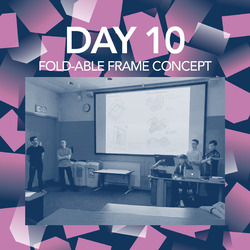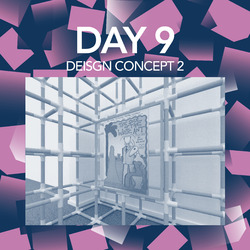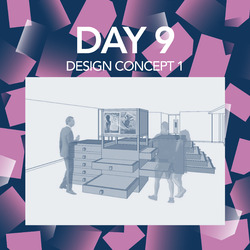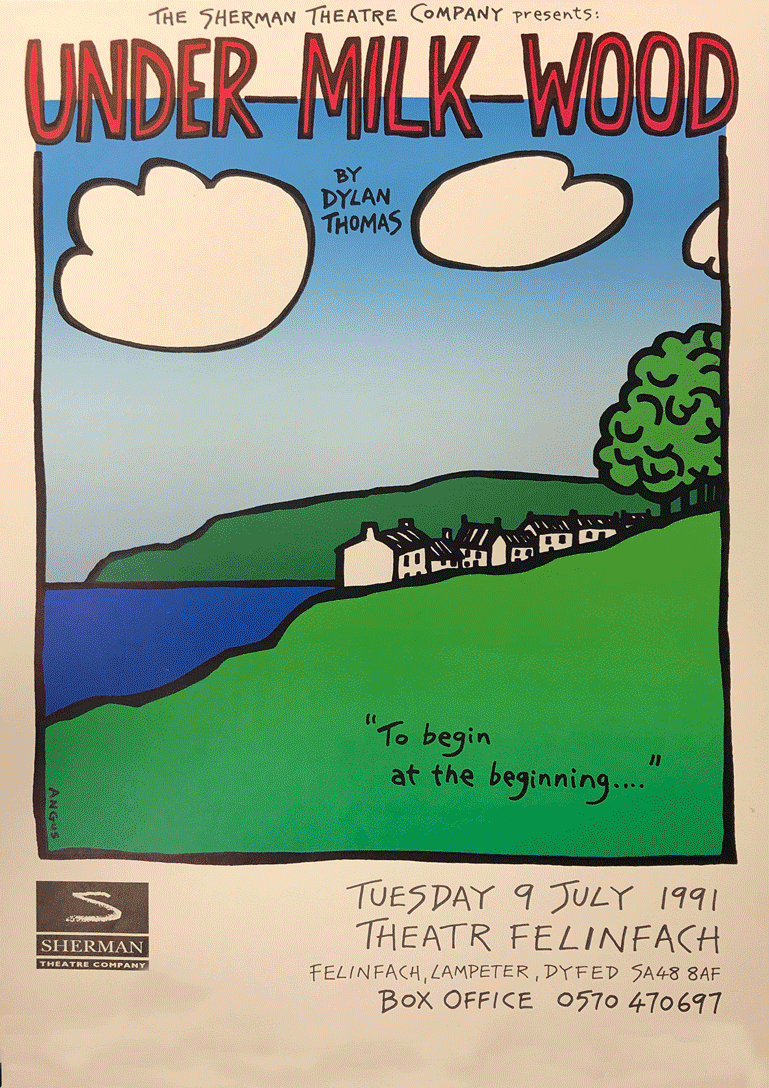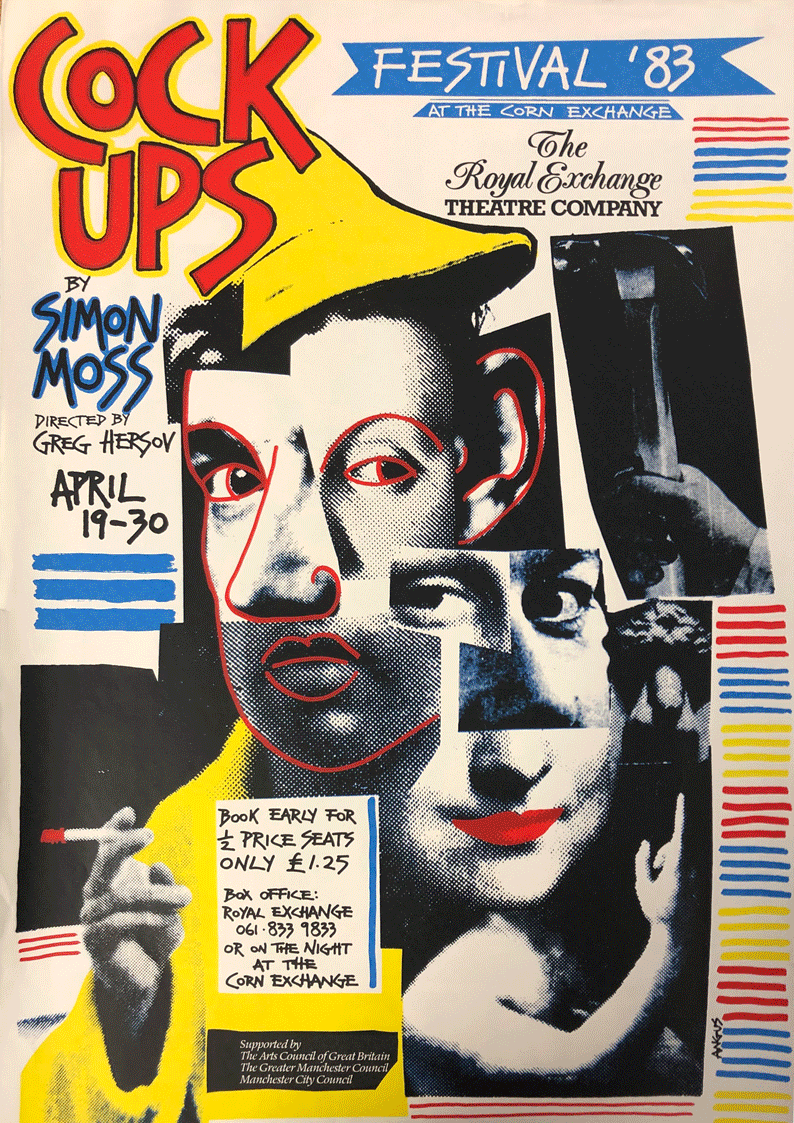The concept of the foldable panel display unit is designed as a single modular unit. Multiple unit can join together and form a larger display to showcase more posters at a time. Interactive elements can add to the display frame to perform different functions
1. Digital display screens can easily showcase multiple posters and can be replaced easily.
2. People can use AR in their smartphones to view the posters in an interactive way.
3. People can also use their smartphones to scan QR codes to read more information about the posters.
Embedded at the top and bottom of each unit are horizontal wires that support vertical wires. Attached to these are cable fittings, capable of holding in place the melinex sleeves housing the posters.These vertical wires move laterally to allow flexibility in the size of the posters they support.
Posted 5 Apr 2019 15:37
This concept is inspired by the purpose of posters. They are used to give information prior to the main event and so to maintain their use, the structure will be mainly placed at the entrance of the exhibition area and will incorporate seating, small nooks and a tunnel. Posters of all sizes will be displayed randomly in glass frames that can accommodate a variety of paper sizes. Our vision is take a 2D element and create a 3D environment to help and encourage the appreciation of posters.
Posted 5 Apr 2019 15:37
The Light Box Project one.
This concept stems from the wanting to challenge the idea of how a poster display should be displayed and to create interactivity between the exhibit and visitors. Posters are stored within case either vertically or horizontally. Visitors will be able to pull out cabinets to find more posters or information. Creating a modular box with varying sizes means that the design can cater for the different sizes of poster collection.
We designed 11 different modules that could be exhibited together or individually, this allows for different sized poster collections to be displayed at the same time.
Cabinets and posters at different heights will mean that both adults and children can enjoy the posters and get up close and personal with them.
Posted 5 Apr 2019 15:36
Srin and Iona presented the Tunnel concept. Janneke was enthusiastic about the critical thought behind the design. Especially the thoughts behind immersing visitors in the posters. She liked how the design could be easily changed depending on the exhibition. Janneke was a bit skeptical about the price of the design, but she did say that if she had the money it would be a great option. She also said that she could imagine the design in one of the large London museums such as the V&A.
Posted 5 Apr 2019 13:37
Ziwen presented the Light Box concept. Janneke loved the key themes of the design and thought the design detailing was thorough and helpful for understanding the feasibility of the project. She especially enjoyed the concept of having the posters displayed on different planes and different heights, in order to engage visitors in a varied manor. She thought the idea of having the posters in glass cases was good because it would simultaneously keep them secure and allow visitors to get up close to the posters.
Posted 5 Apr 2019 13:20
Will presented the Fold-able Frame concept. This seemed to be the design that Janneke preferred. She went as far as to say that the design should be patented as she could realistically see it being used for poster displays. She liked the flexibility and minimal aspect of the design but also really felt assured that the posters would be secure. She liked how the project was scale-able and could be arranged as to guide visitors through the exhibition. Overall this design was a success.
Posted 5 Apr 2019 13:16
Today is the final day so we spent the morning presenting our final design packages to our Collaborator, Janneke, from the Special Collections museum. Like the last Friday, we met with groups I, K and E to present our work together. It was great to see how much was achieved over the fortnight, by all of the groups. Overall, Janneke was really excited with all of the proposals we presented. On regular occasions she said that the output was of a professional standard and that she would love to have everything built.
Posted 5 Apr 2019 13:06
Foldable Display Frame
The concept of the foldable panel display unit is designed as a single modular unit. Multiple units can join together and form a larger display to showcase more posters at a time. Interactive elements can add to the display frame to perform different functions 1. Digital display screens can easily showcase multiple posters and can be replaced easily. 2. People can use AR in their smartphones to view the posters in an interactive way. 3. People can also use their smartphones to scan QR codes to read more information about the posters.
Posted 4 Apr 2019 18:53
The Tunnel Concept
This concept is inspired by the purpose of posters. They are used to give information prior to the main event and so to maintain their use, the structure will be mainly placed at the entrance of the exhibition area and will incorporate seating, small nooks and a tunnel. Posters of all sizes will be displayed randomly in glass frames that can accommodate a variety of paper sizes. Our vision is take a 2D element and create a 3D environment to help and encourage the appreciation of posters.
Posted 4 Apr 2019 18:53
The Light Box Concept
The modular lightbox cabinet design, which they are proposing a cabinet with lightbox integrated on to the surface to display posters. They suggested modular cabinets can come in height which creates this irregularity in a rectangular gridded space.
Posted 4 Apr 2019 18:52
Today we work for the whole day within our groups and finalised all the outputs for our three concepts and we are ready to present our hard work to the special collections tomorrow.
Posted 4 Apr 2019 18:51
Today we focused on refining the three concepts and we made decisions about the materials and details that we will present to the special collections. The three groups are in constant communication to make sure we have 3 distinguishable ideas, but that all the ideas tackle the design challenges set to us by our special collections collaborators. Ziwen's seminar about museum grade materials really helped with making decisions because some of our ideas were instantly ruled out. Tomorrow we will work on making the final presentation and drawing package to present to Janneke on Friday.
Posted 3 Apr 2019 18:26
Another group has developed a framing system which would create a flexible and salable system for the special collections curators to use. The nodes would be 3D printed and the poles would be made out of solid timber. These minimal materials have been chose because they're robust and have a soft visual impact compared to the graphics of the posters. The next thing for this team to develop is how the posters are going to be mounted on to the frame as to be able to display different size posters at different times. But that is for tomorrow....
Posted 3 Apr 2019 18:23
One of our three groups is working on a box module concept. The idea is strong in tackling the issue of storage and preservation of the posters. The design is also interesting because it creates views and angles at which visitors can see the posters. The team is detailing how the posters will be taken in and out, which will be done with a series of draws which visitors can interact with to view the posters.
Posted 3 Apr 2019 18:20
Due to the problems that arose on monday, Ziwen provided an in depth seminar on museum grade materials and how to construct with museum grade standards. The seminar covered air circulation/sealing, UV protection materials and security techniques. These are the features that we need to include in our designs so it was great to get some insight into the industry standards. One of our biggest issues is going to be keeping the posters rigid and in air tight enclosures.
Posted 3 Apr 2019 18:16
Day 7 is over! Today we learned about the adobe design package. Which was really helpful for the afternoon when continued developing our designs. A few problems with our designs have arisen today which we're going to try and solve together tomorrow!
Posted 3 Apr 2019 17:50
We're refining our designs down to detail considerations. Last Friday Janneke and Stephanie said that we needed to pay special attention to how the posters were encased, and how accessible they were when they needed to be changed. We want to propose feasible proposals to the special collections so we're really trying to focus on the detail. We've realised that changing the posters might be a bit of a problem so tomorrow we're going to work together to propose a few different methods.
Posted 3 Apr 2019 17:47
We split into our three groups and resumed our design development. We are all now working on finalizing our designs and delegating the final drawings for each design. Each person in each group will focus on a specific element of the design. For example: one person on concept, one person on user experience, one person on detailed design.
Posted 3 Apr 2019 17:35
Connor started the day by giving a seminar to a packed crowd. The focus was to how to us efficient workflows between photoshop, indesign and illustrator. We Also went through the basic principles of each software and handy tips and tools to use. We then had a long Q&A session which was helpful for sharing each others knowledge about the softwares.
Posted 3 Apr 2019 17:32
We had an internal group review to wrap up the day. Each group shared what they have done for their concept. The co-ordinators also shared their knowledge on detail modelling. All the groups had a productive day and we look forward to see their final output.
Posted 1 Apr 2019 21:34
Each group worked on their detail drawings for their design. Different construction methods were explored for displaying the posters. When working on the details, we have to consider suitable constructions for museum grade materials. We will further explore museum exhibition construction methods in tomorrow's seminar with Zi.
Posted 1 Apr 2019 14:32
The co-ordinators presented the plan for the week ahead, with a focus on detailing and communication. Then the groups continue to work on finalising their concept and organising their drawing output for the week.
Posted 1 Apr 2019 12:22
And that's day 6! Today was focused on developing our concepts in more detail and started preparing for the final portfolio.
Posted 1 Apr 2019 12:19
Week one is over! This week we got to grips with the brief, the poster collection and theoretically understanding how to design an engaging exhibition. We started sketching some rough concepts which we are going to develop further next week.
Posted 29 Mar 2019 14:31
Following the group presentation, Will then gave a thorough seminar on AutoCad. Next week we're going to need to draw details and therefore learning AutoCad now will give us an advantage. Will went through setting up a standard file template that works in various situations, as a part of this he shared a template with line weights and colours already set. He then explained effectively workflows and helpful tools for drawing efficiently. He then went in to how to scale the drawings and print from paper space. Mike and Will then went through a few of their Autocad files they had worked on before to show people how a fully drawn CAD file can look when organised properly. Afterwards we went through an example of a drawing package so that everyone knows what we're going to have to produce for the end of next week.
Posted 29 Mar 2019 14:28
After lunch we all had a conversation summarising the key points we each took from the morning presentation. We decided that it was worthwhile developing parallel projects for the final package, rather than only focusing on one design. We talked about the positives and negatives of each design, and how each one should be developed when we get back to it each week.
Posted 29 Mar 2019 14:19
Today, along with groups I, K and E, we met with our collaborators Janneke and Stephanie to present our progress so far. Each of the events groups had approached their respective projects In a similar way, splitting the large group into smaller sub-groups to develop parallel concepts. Janneke and Stephanie gave us really encouraging feedback. They said that our critical research of exhibition design was really thorough and well thought through. They were skeptical about a few of our concepts and thought we needed to connect our theoretical research more accurately to the designs. They also said that in terms of feasibility we should show our final proposals at varying scales, which we thought would be a really interesting design driver. We agreed that all four groups would reconvene to present our final drawing packages at the end of the events fortnight!
Posted 29 Mar 2019 14:13
Group C: Shreenidhi Srinath, ElsaBerzigotti-Williams, Ioana Naghi are focusing on the tunnel design, they’re interested in creating spaces and seating features using modular frame structure. Ultimately, they want to create a journey for the user to experience.
Posted 28 Mar 2019 22:55
Group B: Kimberly Ng, Stalo Chartoupallou, Neda Vaiciulyte are focusing on a modular lightbox cabinet design, which they are proposing a cabinet with lightbox integrated on to the surface to display posters. They suggested modular cabinets can come in height and weifth which creates this irregularity in a rectangular gridded space.
Posted 28 Mar 2019 22:53
Group A: Dominic Street, Ana Cuc are focusing on the modular poster frames, which they are proposing a modular steel frame display unit that allows for quick installation and hang posters in various sizes. The modular steel frame will also form a new route for the special collection.
Posted 28 Mar 2019 22:51
After visiting the People’s History museum yesterday. The students had basic knowledge on how exhibition displays are designed to keep the posters in museum graded condition. This morning, -we have divided the student up into three smaller groups, and let them start developing their initial conceptual design on the poster display. During the design process, we have set out our criteria on what are the key design element need to put into consideration when rationalize the ideas, the thought listed as following: (Materiality, User journey, number of posters can display in design, how are they stored, Scale of display unit, how to engage with audience, How to categories the posters)
Posted 28 Mar 2019 22:51
A half day for Day 3! Today we visited the People's History Museum. Whilst learning about the history of democracy in Britain we also learnt a lot about exhibition display design.
We studied how information should be layered in order to create hierarchy for the user to engage with. This is done by using different sized font and by the position in which the posters/banners are displayed. We also saw how important it is to keep the artifacts in museum grade conditions. Sometimes, in the case of paper posters, this meant enclosing the piece in an air tight frame. In other cases, like for banners, it meant constantly controlling the conditions of the room and keeping a distance between the public and the banner. In some cases it was a bit of a shame that you couldn't get closer to the banners because their amazing textures and craftsmanship.
Posted 27 Mar 2019 13:23
One of the most interesting features of the museum was the interactive elements. There were varying features which tried to engage the curiosity and participation of the audience. The feature in the image asked people to send in photographs of themselves protesting. The museum then frames the images to show the similarities and differences between forms of protest. This type of interactivity is effective because it makes the audience feel like they are a part of the theme, democracy. Viewers see how important democracy is and can then become a part of the exhibition, thus showing their support for an evolving democracy. This feature also contributes to the strong connection between the exhibition and it's contemporary context.
We decided that we should think of an innovative method of user engagement in our proposal for the Special Collections.
Posted 27 Mar 2019 13:14
Whilst looking around the People's History Museum we learnt a lot about exhibiting posters and other two dimensional objects. One of the key ideas was the creating a clear hierarchy of information. The Peterloo massacre display used different fonts to show varying amounts of information. Key words were hung on banners which depicted the themes of the topic. The displays were hung both on the walls an in the space, this created varying distances from which the posters were viewed. Sometimes it was difficult to tell which bit of information was about each banner. Having a large map of the Manchester placed the exhibition within the wider city, creating a relationship between the museum and it's context.
How and where the posters are mounted, and the varying fonts that we use, are going to be really important in our designs.
Posted 27 Mar 2019 13:01
Today we visited the People's History Museum, the national museum of democracy. The museum tracks the starting routes of democracy in Britain and follows it's progression through a series of momentous occasions. The main exhibition was displayed chronologically but each era was split into four specific themes: revolution, reformers, workers, voters. The topics reflected the content of the era. There was an additional exhibition called Disrupt? Peterloo and Protest, which commemorates 200 years since the Peterloo massacre in Manchester.
We decided to visit the People's History Museum because of their extensive collection of posters and banners. The pieces also vary in scale and fragility, much like the Special Collections poster collection.
Posted 27 Mar 2019 12:45
And that's day 2! Today was focused on detailed site surveying and analysis. We learnt how to accurately measure a space without drawings. Then we learnt some SketchUp skills which we used to model the Special Collections museum space.
Posted 26 Mar 2019 15:47
After lunch Mike gave a SketchUp seminar. He started off going through the basic principles and then a few of the tools and layout setups. We then went on to set up some helpful shortcuts. He also gave us some advice on setting up views for perspectives, and how to export files from SketchUp for use in other programs.
After the tutorial everyone started modelling up the space that we surveyed in the morning. Some people focused on detailing specific details of the room so that we could get a better overall picture of the space. We need the models to be accurate so that we propose realistic sketches of our proposals to Janneke
Posted 26 Mar 2019 14:15
We spent a couple of hours surveying the existing Special Collections space. Each of us started by sketching out a rough plan of the rooms. Then between us we calculated the overall measurements of the space and then different groups focused on accurately measuring specific details.
The aim for the survey was so that we can all digitally model the space in 3D later.
Posted 26 Mar 2019 14:08
Ziwen started Tuesday off with a presentation on site surveying. We went through the purpose of accurately surveying a site/room. He then covered the tools which are commonly used for measuring and recording, for example tape measures and laser measures. He then went through using photography to document relative scales and calculating measurements at varying scales to create comparisons for accuracy.
Posted 26 Mar 2019 13:58
That's the end of day 1! Today we got to know each other and our special collections collaborators. We also started to research a few early ideas of how to proceed with the project.
Posted 25 Mar 2019 18:23
In the afternoon Derek ran an interesting seminar on exhibition design. He started by presenting some of the key considerations that need to be made when approaching an existing space and how to make that space appropriate for different types of exhibition.
He then led an exercise where everyone split into pairs and found precedents of exhibitions which they found interesting. Which we subsequently presented back to the whole group.
The recurring themes were: creating varied, layered experiences that are interactive at different scales and creating an intervention which is easily adaptable and changeable for the museum curators.
Posted 25 Mar 2019 18:22
We then went over to the Special Collections where Stephanie had kindly prepared a select few of the posters to look at. The posters ranged from the 1870's to the present day and hugely varied in content, style and scale.
The session was important because it brought up many obstacles which we may not have foreseen without seeing the real posters. For example, the fragility of the older posters and the huge scale of the newer ones.
We saw only only a select few of the c.3000 posters, we're yet to decide how many at a time it is appropriate to display at one time.
Posted 25 Mar 2019 18:18
We started the day with a great presentation from Janneke, our collaborator from the Special Collections Museum. She explained: the role of the museum within the university, the history of the collections, what collections they had and the future plans for the collections. She then presented what she would like to see from the projects during the events period. The presentation was shared with groups I, K and E as we are all working for the Special Collections. It was great to see what they'll be getting up to and we'll see them all again later in the week to compare progress!
Posted 25 Mar 2019 18:11
Day 1 - 25.03
First we will meet in Lecture Theatre Hall 4, Brooks Building for a presentation by our collaborator.
Then we will head to Chatham 610, our base for the day, and spend an hour introducing ourselves.
After Lunch (13-14) Derek will provide a seminar on Exhibition Design.
The aim for the day is to become acquainted with each other and the project. It is also to have a basic understanding of exhibition design and the specific requirements of the Special Collections.
Posted 20 Mar 2019 10:48
This is his "Theatre Posters" collection for:
The Dukes, Lancaster; The Young Vic Theatre, London; Contact Theatre, Manchester; Theatre Foundry; Wigan Music Theatre; Croydon Warehouse Theatre; Royal Exchange Theatre, Manchester; Liverpool Playhouse; Paines Plough; Leicester Haymarket Theatre; The Traverse Theatre Company, Edinburgh; M6 Theatre Company; North West Spanner; Polka Theatre for Children, London; Access Theatre; Our Lady’s High School, Lancaster; Sherman Theatre, Cardiff.
*All credits goes to John Angus and MMU Special Collections
Posted 3 Mar 2019 20:00
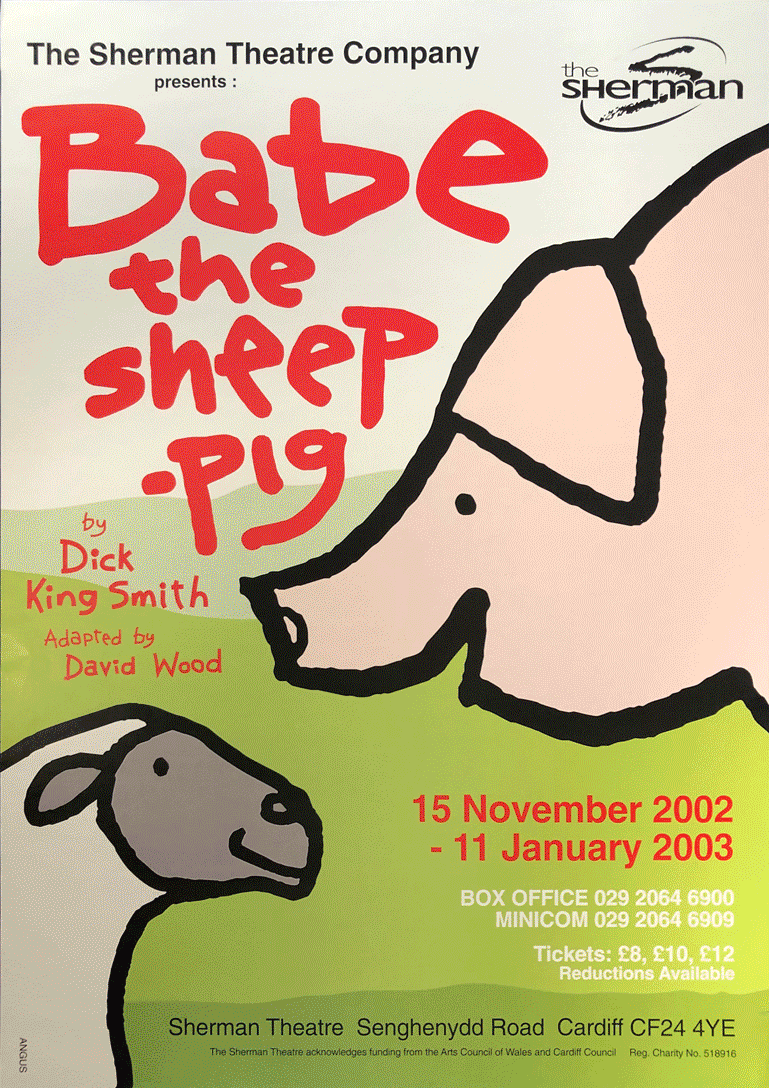
Some of his recent prints have been exhibited in open submission exhibitions as follows:
2014 Neo Gallery, Bolton. Neo Print Prize – Prize Winner
2014 PR1 Gallery, University Central Lancashire. ZZ2Z – An exhibition of prints
2014 Galeria La Candela, Mexico City, Mexico. A’ al Oochel – print exchange
2015 PR1 Gallery, University Central Lancashire. A’ al Oochel – print exchange
2015 Chapel Gallery, Ormskirk. Fine Print
2015 Bankside Gallery, London. National Original Print Exhibition 2015
2015 China Printmaking Museum, Shenzhen, China. Formation-2015
2016 Bankside Gallery, London. National Original Print Exhibition 2016
2016 Warrington Art Gallery. Contemporary Art Festival Open Exhibition WCAF16
2016 Bankside Gallery, London. The Masters 2016
2016 Jinan Art Museum, China. First Xuyuan International Printmaking Biennale
2017 Bankley Gallery, Manchester. The Bankley Open Call 2017
2017 Warrington Art Gallery. Contemporary Art Festival Open Exhibition WCAF17
2018 PS Mirabel, Manchester. Diptych, Triptych and Polyptych
2018 Surface Gallery, Nottingham. Reflection – Contemporary Portraiture Open
2018 Banks Mill, Derby. Derby Print Open
2018 Chapel Gallery, Ormskirk. Lancashire Open 2018. First Prize
2018 West Yorkshire Print Workshop. Flourish Award 2018
2018 Bankside Gallery, London. The Masters: Screen and Stone
2018 PR1 Gallery, Preston. Flourish Award 2018
2018 University of Central Lancashire, The State of Print
*All credits goes to John Angus and MMU Special Collections
Posted 3 Mar 2019 19:59
In 2013-14, he was awarded an Artists’ Access to Art College (AA2A) placement in the print department at the University of Central Lancashire, and this is where he started printmaking again.
*All credits goes to John Angus and MMU Special Collections
Posted 3 Mar 2019 19:57
John is based in Lancaster, in North West England. He produced posters for a wide variety of arts events around the UK from 1975 to 2003. He screen-printed many of these posters, and a selection can be seen at johnangusposters.com
*All credits goes to John Angus and MMU Special Collections
Posted 3 Mar 2019 19:54
Last week, we met with Stephanie Boydell from the Special Collections in the MMU Library to discuss about the final details for our final presentation!
We had a chance to look some of the poster collections from MMU as well as the artist John Angus.
The special collections kindly provided us a day on the 25th March to showcase to the BA students some of their 8000 + poster collection! It will be a great opportunity to let students see what they will be designing for!
At the end of the two weeks of events, the BA students will be presenting their work along with other events group that are collaborating with the Special Collections.
Special thanks to John and MMU Special Collections for the wonderful poster collection!
Posted 3 Mar 2019 19:32
The Peoples History Museum contains a large collection of posters and collections which are in display over 2 different large spaces. A planned site visit to understand better how museum collections can also have interactive elements!
Posted 11 Feb 2019 18:53
Seminar 1: Exhibition Design
This seminar, the students will look at the basic theories and logistic behind the exhibition design and museum curation.
Posted 11 Feb 2019 16:36
Seminar 2: Sketch Up & 3D Modelling
This seminar, the students will look at the drawing software Google Sketch Up and rendering techniques.
Posted 11 Feb 2019 16:35
Seminar 3: Adobe Design Package
This seminar, the students will look at the Adobe softwares such as Photoshop, Illustrators and InDesign.
Posted 11 Feb 2019 16:35
Seminar 4: Portfolio Presentation
This seminar, the students will look at how to create a presentation and design package.
Posted 11 Feb 2019 16:35
Seminar 5: Design Detailing
This seminar, the students will look at the basic museum exhibition methods, joinery methods and understanding how to work with museum grade material.
Posted 11 Feb 2019 16:35
Event Schedule
Throughout the fortnight we will be working towards designing three different proposals for the poster display case. We will consistently work towards the final output, a comprehensive drawing package. Times of group study and design development will be supplemented with visits and seminars, delivered by the event coordinators.
We really want the two weeks to be relaxed, creative and productive!
Posted 11 Feb 2019 14:48
Our first superb Event 2019 presentation last week in Manchester School of Architecture! Thank you to all who attended, your energy was amazing, and most of all, thank you to @BeckySobell for making this all possible.
We are looking forward to work side by side with you guys to explore ideas beyond the discipline of architectural education.
Posted 4 Feb 2019 16:17
We're team V and we're the master's students who will be coordinating the Poster Re-poster events group. Nice to meet you!
Posted 29 Jan 2019 16:52
As a team we will be designing a museum grade display case for a selection of the c.8000 piece international poster collection held by the Special Collections Museum in the MMU Library. The collection doesn’t have an existing display unit and is therefore invisible to the public for most of the time, we would like to change that!
Our final output will be a detailed drawing package of our proposal, which we will submit to the special collections team at the end of the event. The drawing package will include: GA plans of the spaces the case could occupy, detailed drawings of our proposal and visualisations and diagrams of how users will interact with the collection.
We will be simultaneously developing both our creative and detail design skills by efficiently following the design process from problem to concept to solution. In order to develop these skills, there will be appropriate seminars led by the master's students which will go alongside the project development.
Posted 9 Jan 2019 11:07





